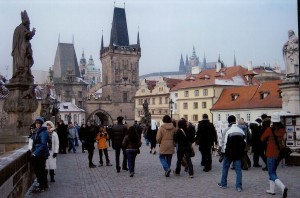
Ask any serious storyteller if he can remember the first story he told in public. I’m sure he can; most vividly. I certainly remember mine.
It happened at school in Austria many years ago. I must have been about ten or eleven at the time. Before sending us home for the day, our teacher told us that we would all have to tell a little story to the class the next day. Instead of being intimidated by this, I was actually very excited. I had been telling stories to my grandmother and my two great aunts who were living with us, for years. I remember when they got tired of listening to me, I used to tell stories to Lumpi, our dachshund, who was usually asleep by the fire. So, the most difficult thing for me was not to think of a story I could tell in class, but which one to choose. I settled on the one about the Major and the photograph; one of my favourites.
When the teacher called us – one by one – to the blackboard the next day, I could hardly wait for my turn. This is the story I told the class:
“It happened in Prague on a warm Sunday morning in the spring of 1904. The dashing young officer – a major in the Austro-Hungarian army – had just arrived by train from Budapest. Looking very dapper in his uniform as he crossed the CharlesBridge, he was on his way up to the castle to meet a friend.

Not only the young women promenading on the bridge, but even the haughty matrons hurrying to church turned their heads as he walked past. When he left the bridge and entered the Little Quarter, something caught his eye in the shop window of a well known photographer. The major stopped, lit a cigarette, and looked at the photograph displayed on an easel in the window. It was a portrait of a young woman sitting on a chaise lounge. She looks like a Greek goddess, he thought, fascinated by the striking woman in the photograph. The officer stood there for a long while, oblivious of the throng of the passers by giving him curious looks.
The major returned to the studio on Monday morning and asked to speak to the photographer who had taken the picture he had so admired the day before.
‘Can you tell me who that young woman is in the photograph over there?’ he asked, pointing to the picture in the window. At first, the photographer was evasive, and didn’t want to provide any information. The major insisted. In those days, one didn’t refuse a request made by a senior officer in the Austro-Hungarian army. Rolling his eyes, the photographer relented with a shrug, reached under the counter, and opened his appointment book.
‘The young lady is the daughter of a prominent doctor,’ he said. ‘The photograph was taken in the family home here in Prague a month ago.’
‘May I have a name and an address, please?’ asked the officer.
‘The family lives near Bertramka …’
‘The villa where Mozart composed the overture to Don Giovanni a few hours before its premiere?’ interrupted the major.
‘That’s the one. The doctor lives next door.’
‘I know where it is.’
The major called on the doctor the next day, introduced himself and described the curious incident with the photograph in the window.
‘I can’t quite explain it, but something about the young lady has affected me deeply …’ he told the doctor. ‘Is she here? Would it be possible to meet her?’
‘Yes,’ said the doctor, smiling, ‘come.’ He took the major to an open window overlooking a beautiful garden at the back of the house, and pointed to a young woman of about 18, sitting on a bench with a book in her lap. Looking up, she waved to her father. When her eyes turned to the handsome stranger in the uniform standing next to him, her heart missed a beat.
Three months later, the major and the young woman were married. That’s how my grandfather met my grandmother.”




